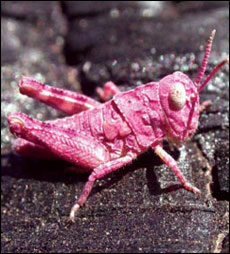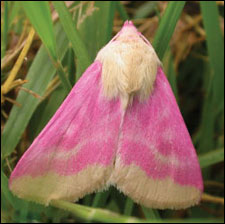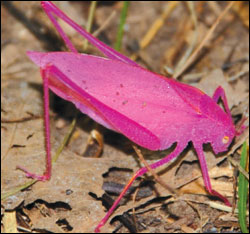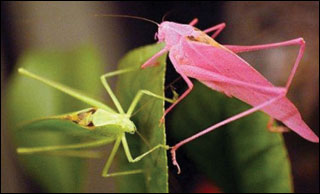|
Nature trail
Pink is hot...
All the colours of the rainbow are represented in the Animal Kingdom.
Our animal friends that walk, slither, creep or crawl on land, roam the
wide blue skies or swim and slither in the deep blue oceans all sport
various hues. Some of these animals are truly dazzling and breathtaking.
|

A striking pink grasshopper |
If anyone were to ask you to crown the most spectacularly coloured
creature, it sure would prove to be a difficult choice to make. For
example, the peacock with its iridescent (colours that seem to change
with light) blue feathers we are so familiar with and admire so much may
even pale when compared to the beautiful blue bird of paradise.
In fact, most bird of paradise species are vibrantly hued and are
spectacular. The toucans and macaws are also feathered beauties that
never fail to dazzle us with their vibrant colours.
Then, if you look at creepy crawlies like the coral snakes that have
brightly coloured skins of black, yellow and red or orange, amphibians
such as Arrow poison frogs or big cats like the Bengal tigers, leopards
and jaguars, they would all seem so spectacular. And what about the
flying jewels, the butterflies?
They are simply awesome. So, let's not even try to attempt to crown
the most spectacular animal going by its colours and do some
investigation instead about some members of the Animal Kingdom who are
sporting a colour that's rather unusual.Yes-pink, which we in our human
world mostly associate with the female species of mankind. But, not so
in the Animal Kingdom. No, some males species certainly don't seem to be
shy about being 'pink'. Let's see, which animals are generally pink.
|

Pink and yellow moth. |
There are the famous feathered beauties - the flamingoes who capture
the imagination of many an artist with their shocking pink feathers,
supposed to be caused by a certain nutrient in the food, shrimp, they
eat, then there are the rolly-polly, obese friends, pigs many of whom
appear to be very pink because of the fine layer of hair which expose
their skins, the naked mole rats who cannot be anything but pink, since
they have greatly reduced hair or no hair at all on their bodies, and of
course the cute mammals found in the Amazon River and tributaries - the
pink river dolphins, which we featured in the Junior Observer sometime
ago.
But these are not the only creatures sporting pink. Remember we
recently highlighted about a newly discovered millipede which is
shocking pink in colour? Yes, like them there are many others that are
pink in colour, especially in the insect world.
|

Hot pink katydids(below and right) |
One of the stories featured in the From Abroad page today is about
another such pink insect discovered by a schoolboy in England. So, today
we decided to focus your attention on some of these unusual pink insects
which include stick insects, dragonflies, moths, mantises, grasshoppers
and katydids...Wondering what on earth the last name means? Well, many
of you may not be familiar with these particular insects, but they are
members of the Tettigonidaes family and are also known as bush crickets
or long-horned grasshoppers, even though they are more closely related
to crickets.
They are large, winged, singing insects which range in size. On
average they are 1 1/2 to 5 inches long (3-12.5 cm) have large hind legs
and are distinguished by their extremely long, thread-like antenna, that
can even exceed body lengths.
Even though the katydids are usually green or brown in colour there
are some hair which are shocking pink in colour and very striking.
Scientists attribute this strange colouration to a condition known as
erythrism; an unusual reddish pigmentation that can affect an animal's
body, skin, feathers, hair or eggshells.
What causes it? It is believed that either the diet (like in
flamingoes perhaps) or a genetic mutation leads to either the absence of
a normal pigment or the excessive production of another.
As most of these insects live among plants, scientists believe that
the pink colouration may be a form of camouflage for them to hide among
reddish or pinkish coloured plants.
Why have these insects been given such an unusual name? It has
everything to do with the sound they make, which basically goes like
"Katy did, Katy didn't." So, they are identified as katydids.
Katydids are nocturnal and arboreal creatures that generally sing in
the evenings. Males have song pods located in their front wings which
they use for their shrill songs. The females chirp in response.
Katydids are found in abundance, especially in the tropics. There are
more than 6,400 species and out of these about 255 are found
|

Grasshoppers in pink
and green. |
in the United States. But there are over 2,000 species in the Amazon
rainforest alone.
Let's check out a few more insects who want to be flashy like rock
stars and stick out in appearance. The Pink mantis is one and the pink
stick insect is another. Then there are some moths like the Pink furry
moths or the Rosy Maple moths.
The Rosy Maple moths have furry yellow bodies and pink wings with a
distinct yellow triangle on them.
The Roseate Skimmer male dragonflies are another species of hot pink
creatures characterised by their bright pink abdomen. (The females
generally have orange bodies). The younger the (male) dragonfly, the
brighter its pink tone. Roseate skimmers are common in the Americas.
Check out what other animals are predominantly pink in the Animal
Kingdom.
**********
Fact file on insects
* There are more than 18,000 species of grasshoppers in the world,
living in all kinds of habitats.
* Grasshoppers can jump 20 times their body length.
* The Painted grasshoppers which is a mixture of yellow, black or
white colours, is the longest, at 11 cm.
* Grasshoppers can be distinguished from crickets and katydids by
their short, thick horns.
* Praying mantises are more closely related to termites and
cockroaches than to the more similar looking crickets and grasshoppers.
It gets its name from the praying stance it takes. More than 9,000
species are known and are found mainly in the temperate and tropical
climates of the world.
* Locusts are also a kind of grasshopper, but they change their
colour and behaviour at high population densities.
* Some creatures sport pink in conjunction with yellow which happens
to be the complimentary colour of pink.
* Going by colour theory, two colours that produce a natural colour
like grey, white or black, when mixed in proper proportions, is
identified as complimentary colours. So, pink mixed with yellow can
certainly prove to be a good camouflage from prey when seen from above
especially. All they would see is some sort of grey!
Facts and pix: Internet
********** |

